City and capital, nomss (department) of Ioannina, in the Epirus (Epiros) region of northwestern Greece. It is located on a plateau on the western side of Lake Ioannina (ancient Pambotis), facing the gray limestone mass of Mount Mitsikeli. Ioannina was first mentioned in ecclesiastical registers of the 9th and 10th centuries as an important Byzantine city. 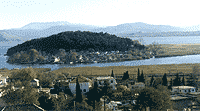 At the end of the 11th century the castle of Ioannina was occupied by the Norman Boemund and at the beginning of the 14th century the city and its surrounding area came under Byzantine rule.That period,Ioannina was to play a central role in the development of the Despotate of Epirus and the dissemination of knowledge and state education.
At the end of the 11th century the castle of Ioannina was occupied by the Norman Boemund and at the beginning of the 14th century the city and its surrounding area came under Byzantine rule.That period,Ioannina was to play a central role in the development of the Despotate of Epirus and the dissemination of knowledge and state education. 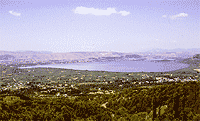 After 1318 it reverted to the Byzantine Empire and was made a metropolitanate by Andronicus II, but in 1349 it fell to the Serbs. Subsequently it was contested by the Italians, Albanians, and Turks, to whom it succumbed about 1430.In 1430,the city surrendered to Sinan Pasha and in the year 1611,bishop Dionysus the Philosopher organized a failed revolutionary movement.
After 1318 it reverted to the Byzantine Empire and was made a metropolitanate by Andronicus II, but in 1349 it fell to the Serbs. Subsequently it was contested by the Italians, Albanians, and Turks, to whom it succumbed about 1430.In 1430,the city surrendered to Sinan Pasha and in the year 1611,bishop Dionysus the Philosopher organized a failed revolutionary movement.
At the end of the 18th century and at the beginning of the 19th century the city had as administrator the Pasha Alis Tepelenlis and Ioannina acquired a special political significance within the ottoman regime.The extermination of Alis Pasha in 1822 took place at the height of his administrative power, as evidenced by the city's economic and social lifewhose revolt against the sultan's rule, although quickly suppressed by his assassination, helped trigger the War of Greek Independence (1821-29). Ioannina was long famous for its Schools, founded by Michael Philanthropinos (1682-1758), Leondati Giouma (1675-1725),and Meletios(1690), later Bp of Athens and a noted historian and geographer.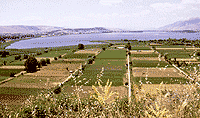 They were all destroyed in the fire of 1820.Finally the city was liberated by Greek forces in 1913 and Ioannina and southern Epirus were finally united with the Greek kingdom in 1913.As a regional agricultural and commercial centre, Ioannina declined somewhat with the partition of Epirus between Greece and Albania in 1913.
They were all destroyed in the fire of 1820.Finally the city was liberated by Greek forces in 1913 and Ioannina and southern Epirus were finally united with the Greek kingdom in 1913.As a regional agricultural and commercial centre, Ioannina declined somewhat with the partition of Epirus between Greece and Albania in 1913.
The city remains the commercial centre of Epirus and is noted for its metalwork and embroidery. It is the seat of a metropolitan bishop and a divisional headquarters of the Greek army. The University of Ioannina opened in 1970. And so today is a modern urban centre with a distintly human character thanks to the traditions of Epirus.
As an administrative,economic and intellectual centre of northwestern Greece, it commands the attention of the international community through its university.
 At the end of the 11th century the castle of Ioannina was occupied by the Norman Boemund and at the beginning of the 14th century the city and its surrounding area came under Byzantine rule.That period,Ioannina was to play a central role in the development of the Despotate of Epirus and the dissemination of knowledge and state education.
At the end of the 11th century the castle of Ioannina was occupied by the Norman Boemund and at the beginning of the 14th century the city and its surrounding area came under Byzantine rule.That period,Ioannina was to play a central role in the development of the Despotate of Epirus and the dissemination of knowledge and state education.  After 1318 it reverted to the Byzantine Empire and was made a metropolitanate by Andronicus II, but in 1349 it fell to the Serbs. Subsequently it was contested by the Italians, Albanians, and Turks, to whom it succumbed about 1430.In 1430,the city surrendered to Sinan Pasha and in the year 1611,bishop Dionysus the Philosopher organized a failed revolutionary movement.
After 1318 it reverted to the Byzantine Empire and was made a metropolitanate by Andronicus II, but in 1349 it fell to the Serbs. Subsequently it was contested by the Italians, Albanians, and Turks, to whom it succumbed about 1430.In 1430,the city surrendered to Sinan Pasha and in the year 1611,bishop Dionysus the Philosopher organized a failed revolutionary movement. At the end of the 18th century and at the beginning of the 19th century the city had as administrator the Pasha Alis Tepelenlis and Ioannina acquired a special political significance within the ottoman regime.The extermination of Alis Pasha in 1822 took place at the height of his administrative power, as evidenced by the city's economic and social lifewhose revolt against the sultan's rule, although quickly suppressed by his assassination, helped trigger the War of Greek Independence (1821-29). Ioannina was long famous for its Schools, founded by Michael Philanthropinos (1682-1758), Leondati Giouma (1675-1725),and Meletios(1690), later Bp of Athens and a noted historian and geographer.
 They were all destroyed in the fire of 1820.Finally the city was liberated by Greek forces in 1913 and Ioannina and southern Epirus were finally united with the Greek kingdom in 1913.As a regional agricultural and commercial centre, Ioannina declined somewhat with the partition of Epirus between Greece and Albania in 1913.
They were all destroyed in the fire of 1820.Finally the city was liberated by Greek forces in 1913 and Ioannina and southern Epirus were finally united with the Greek kingdom in 1913.As a regional agricultural and commercial centre, Ioannina declined somewhat with the partition of Epirus between Greece and Albania in 1913. The city remains the commercial centre of Epirus and is noted for its metalwork and embroidery. It is the seat of a metropolitan bishop and a divisional headquarters of the Greek army. The University of Ioannina opened in 1970. And so today is a modern urban centre with a distintly human character thanks to the traditions of Epirus.
As an administrative,economic and intellectual centre of northwestern Greece, it commands the attention of the international community through its university.
Konitsa
Konitsa appears in history at the time of Kon/nos Pogonatos. In 1453, Konitsa came under the Turkish rule and was liberated in 1913. During Ali Pashas occupation, Konitsa presented economic development as it became the transit center to Balkans and Europe. 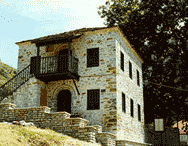 In 1940-41 Konitsa was attacked by both Italians and raids of Albanian teams. While the price of the Civil War to Konitsa was rather dear as the town lost whole families.
In 1940-41 Konitsa was attacked by both Italians and raids of Albanian teams. While the price of the Civil War to Konitsa was rather dear as the town lost whole families.
The entire area of Konitsa comprises remarkable and interesting tourist sights, that combined with the natural environment, the rich and interesting vegetation and the unique local architecture have become the main tourist resources of the region.
The town of Konitsa spreads at the hill of Trapezitsa mountain and lies at the the height of 600m approximately. As far as the bottom of the hill of Konitsa is extended the plain of Konitsa and Klidonia.
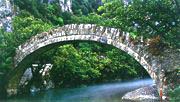 This plain is the meeting point of three rivers: Sarantaporos, Aoos and Voidomatis. The area is bordered by the mass volumes of the mountains Grammos on the north, Smolikas on the east, Gamila on the south and Camenic and Nemertzika on the west.
This plain is the meeting point of three rivers: Sarantaporos, Aoos and Voidomatis. The area is bordered by the mass volumes of the mountains Grammos on the north, Smolikas on the east, Gamila on the south and Camenic and Nemertzika on the west.
The morphology of the ground as well as the hydrography of the area form four natural ranges:
a. the valley of Sarantaporos (on the north),
b. the valley of Aoos (on the east),
c. the basin of Konitsa (on the south),
d. the alpine zone.
Regarding the origin of the name of Konitsa, there are various assumptions. According to the tradition, the town of Konitsa is built on the ancient Konissos. The historian from Epirus, P.Aravantinos, assumes that the name of the area comes from the name of the ancient town Knossos that was gradually developed into Konitsa. Also, the traveler Poukevil considers that this name comes from the slavic name, Konitza, which means horses place. According to another legend, the nobleman Koni had built a castle whose ruins lie above the chapel of St.Varvara. So, the town might have taken its name by this nobleman.
 In 1940-41 Konitsa was attacked by both Italians and raids of Albanian teams. While the price of the Civil War to Konitsa was rather dear as the town lost whole families.
In 1940-41 Konitsa was attacked by both Italians and raids of Albanian teams. While the price of the Civil War to Konitsa was rather dear as the town lost whole families.The entire area of Konitsa comprises remarkable and interesting tourist sights, that combined with the natural environment, the rich and interesting vegetation and the unique local architecture have become the main tourist resources of the region.
The town of Konitsa spreads at the hill of Trapezitsa mountain and lies at the the height of 600m approximately. As far as the bottom of the hill of Konitsa is extended the plain of Konitsa and Klidonia.
 This plain is the meeting point of three rivers: Sarantaporos, Aoos and Voidomatis. The area is bordered by the mass volumes of the mountains Grammos on the north, Smolikas on the east, Gamila on the south and Camenic and Nemertzika on the west.
This plain is the meeting point of three rivers: Sarantaporos, Aoos and Voidomatis. The area is bordered by the mass volumes of the mountains Grammos on the north, Smolikas on the east, Gamila on the south and Camenic and Nemertzika on the west.The morphology of the ground as well as the hydrography of the area form four natural ranges:
a. the valley of Sarantaporos (on the north),
b. the valley of Aoos (on the east),
c. the basin of Konitsa (on the south),
d. the alpine zone.
Regarding the origin of the name of Konitsa, there are various assumptions. According to the tradition, the town of Konitsa is built on the ancient Konissos. The historian from Epirus, P.Aravantinos, assumes that the name of the area comes from the name of the ancient town Knossos that was gradually developed into Konitsa. Also, the traveler Poukevil considers that this name comes from the slavic name, Konitza, which means horses place. According to another legend, the nobleman Koni had built a castle whose ruins lie above the chapel of St.Varvara. So, the town might have taken its name by this nobleman.
Metsovo
History mentions that in the Second Millennium B.C. a pastoral group of people who spoke Greek lived in this section of Epirus. More specifically, during the 4th century B.C. the Aithikes and perhaps the Tymphaioi lived in the region of Metsovo. 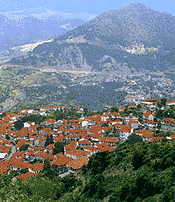 The manners and customs of the inhabitants of Metsovo region do not differ from those those of Epirus, while many peculiarities obviously, give them an affinity with practices deriving from as far back as Homeric times.
The manners and customs of the inhabitants of Metsovo region do not differ from those those of Epirus, while many peculiarities obviously, give them an affinity with practices deriving from as far back as Homeric times.
Metsovo, because of its position as a central juncture in the interior system of communications and as an absolutely necessary stopping point for taking on supplies and the control of the only pass through the Pindus mountains, must be one of the oldest settlements in the region. Most probably it was the first set up after the destruction of the Roman settlement, “Imperatori”. The inhabitants formed a unique society which has carried over to our times, ancient experiences from life on the peaks of the Pindus.
The Roman Empire took the form of “armed association” because it was primarily interested in the protection and fortification of the region which for the Romans was above all an important not to say crucial pass from the southern shores of Epirus to Thessaly and Macedonia. This “symbiosis” could not overthrow the “world” of a primitive, untamed, unique and closed society while it was was natural to cultivate bi-lingualism for practical purpose that is, for the needs of daily communication and co-operation with the Roman administration.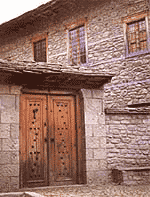 The inhabitants are still bilingual today. They speak Greek and Vlach, which is a Latinate language with quite a number of ancient Greek terms, but without its own written form.
The inhabitants are still bilingual today. They speak Greek and Vlach, which is a Latinate language with quite a number of ancient Greek terms, but without its own written form.
The place name “Metsovo” first appeared in in late Byzantine times. Many opinions exist concerning the origin of its name. Some claim that the name of the village has Slav origins (mets+ovo = bear village) and other believe it is derived from the Greek (Meso-Vouni= mid - mountain, shortened to Mesovo and hence Metsovo) because of its location as a passageway being right in the middle of the region.
It is worth noting that the inhabitants of Metsovo, throughout its history, have nearly always lived in a state of autonomy. More particularly, from the 10th century to the beginning of the 19th century, Metsovo constituted a privileged region, a condition successively conferred on it by Constantine Porphyrogennitus in the 10th century, Andronicus III in the 14th century, Murat II in 1430 and the Sublime Porte in 1695.
Metsovo suffered considerable destruction on March 27, 1854 from the Ottoman troops of Abdi Pasha during the uprising of the Metsovians under the chieftain Grivas. In spite of all the destruction which took place , with the help of bequests by prominent Metsovite benefactors living abroad, Metsovo began a new period of growth whose rhythms were accelerated by its liberation from the Ottoman yoke on October 31, 1912.
The establishment of the Baron Michael Tosssizza Foundation in 1948 by the baron himself, with the encouragement and inspiration of Evangelos Averoff - Tossizza, was the decisive event for the economic and cultural development of today's Metsovo. Its residents, making good use of the above privileges, of local traditions and of natural resources made this community "built of wood and stone" into a noteworthy location both for the local community and for all visitors.
Today, Metsovo, is one of the most famed traditional settlements in Greece. Its fame is largely due to the beauty of the village, to it's traditional way of life, to the quality and delicacy of its products and its successful development.
 The manners and customs of the inhabitants of Metsovo region do not differ from those those of Epirus, while many peculiarities obviously, give them an affinity with practices deriving from as far back as Homeric times.
The manners and customs of the inhabitants of Metsovo region do not differ from those those of Epirus, while many peculiarities obviously, give them an affinity with practices deriving from as far back as Homeric times.Metsovo, because of its position as a central juncture in the interior system of communications and as an absolutely necessary stopping point for taking on supplies and the control of the only pass through the Pindus mountains, must be one of the oldest settlements in the region. Most probably it was the first set up after the destruction of the Roman settlement, “Imperatori”. The inhabitants formed a unique society which has carried over to our times, ancient experiences from life on the peaks of the Pindus.
The Roman Empire took the form of “armed association” because it was primarily interested in the protection and fortification of the region which for the Romans was above all an important not to say crucial pass from the southern shores of Epirus to Thessaly and Macedonia. This “symbiosis” could not overthrow the “world” of a primitive, untamed, unique and closed society while it was was natural to cultivate bi-lingualism for practical purpose that is, for the needs of daily communication and co-operation with the Roman administration.
 The inhabitants are still bilingual today. They speak Greek and Vlach, which is a Latinate language with quite a number of ancient Greek terms, but without its own written form.
The inhabitants are still bilingual today. They speak Greek and Vlach, which is a Latinate language with quite a number of ancient Greek terms, but without its own written form.The place name “Metsovo” first appeared in in late Byzantine times. Many opinions exist concerning the origin of its name. Some claim that the name of the village has Slav origins (mets+ovo = bear village) and other believe it is derived from the Greek (Meso-Vouni= mid - mountain, shortened to Mesovo and hence Metsovo) because of its location as a passageway being right in the middle of the region.
It is worth noting that the inhabitants of Metsovo, throughout its history, have nearly always lived in a state of autonomy. More particularly, from the 10th century to the beginning of the 19th century, Metsovo constituted a privileged region, a condition successively conferred on it by Constantine Porphyrogennitus in the 10th century, Andronicus III in the 14th century, Murat II in 1430 and the Sublime Porte in 1695.
Metsovo suffered considerable destruction on March 27, 1854 from the Ottoman troops of Abdi Pasha during the uprising of the Metsovians under the chieftain Grivas. In spite of all the destruction which took place , with the help of bequests by prominent Metsovite benefactors living abroad, Metsovo began a new period of growth whose rhythms were accelerated by its liberation from the Ottoman yoke on October 31, 1912.
The establishment of the Baron Michael Tosssizza Foundation in 1948 by the baron himself, with the encouragement and inspiration of Evangelos Averoff - Tossizza, was the decisive event for the economic and cultural development of today's Metsovo. Its residents, making good use of the above privileges, of local traditions and of natural resources made this community "built of wood and stone" into a noteworthy location both for the local community and for all visitors.
Today, Metsovo, is one of the most famed traditional settlements in Greece. Its fame is largely due to the beauty of the village, to it's traditional way of life, to the quality and delicacy of its products and its successful development.

